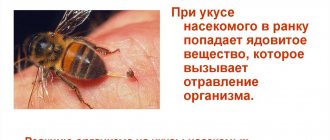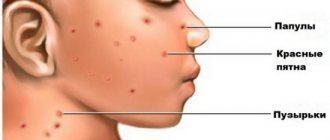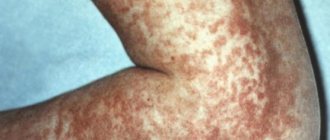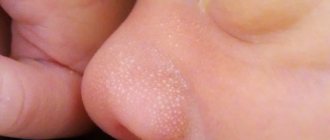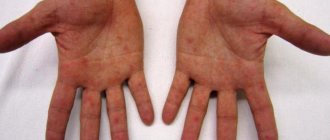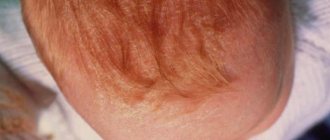Human skin can be called an indicator of health. This is especially true for a small child, whose skin is very sensitive to any changes - both in external conditions and in the general condition of the internal organs and systems of the body.
Skin rashes can be of different types. Some of them are not dangerous, others are a signal of the development of an allergic, infectious or autoimmune process. You cannot ignore a rash in a child or treat it yourself without finding out the root cause.
Skin rashes are a very common occurrence in young children.
Types of rashes in babies
In dermatology, there are three large groups into which all possible skin rashes in infants are divided:
- Physiological. This type of rash occurs in newborns. Rashes appear on the body as a result of hormonal changes occurring in the body.
- Immunological. It is a consequence of exposure to various irritating factors on the epidermis, such as allergens, temperature or friction. Such rashes include urticaria, prickly heat, an allergic reaction, or atopic dermatitis. Violation of basic hygiene rules can also lead to unwanted manifestations.
- Infectious. A rash is a symptom that accompanies a certain infectious (viral) disease, for example, chicken pox or scarlet fever (more details in the article: how is an infectious rash in children with viral exanthema treated?).
Causes of rashes
There are many reasons why rashes may appear on the head, face, arms, legs, sternum, back or back of the head. The most likely are:
- Viral diseases. These include measles, rubella, chickenpox, and mononucleosis.
- Diseases of bacterial etiology. For example, scarlet fever.
- Allergy. Food products, hygiene products, clothing, household chemicals, perfumes and cosmetics, and insect bites can cause an allergic reaction.
- Mechanical damage to the epidermis. If the wound is treated insufficiently, irritation of the skin around it may begin, manifested in the form of pimples, white spots, colorless blisters, goosebumps, red or pink spots.
- Problems with blood clotting. In this situation, the rash consists of small hemorrhages characteristic of meningococcal meningitis.
So, rashes in babies come in different types and have different etiologies. It is not worthwhile to independently diagnose and determine the type of rash using photos from the Internet, even with good explanations. This should be done by a specialist.
Diseases accompanied by rashes
Any type of rash on the body is a symptom of the disease. They can be very different in appearance. The rash can be papular, pinpoint or, conversely, in the form of large dots or pimples. It comes in a variety of colors, ranging from clear or white to bright red. The characteristics that describe rashes directly depend on their etiology or the illness that they accompany.
Dermatological diseases
Among the diseases of dermatological etiology, the symptoms of which are a variety of rashes, the following can be noted:
- dermatoses (for example, diaper dermatitis);
- psoriasis;
- eczema;
- candidiasis and other diseases of the epidermis.
Almost always, skin diseases are caused by problems with internal organs and systems combined with exposure to external factors. For example, neurodermatitis can be triggered by malfunctions of the nervous and endocrine systems due to decreased immunity. In such a situation, complex therapy is required using medications, and not just ointments or creams.
Psoriasis on the hands of a child
As for psoriasis, at the initial stage it looks like an allergic reaction, but over time the plaques acquire a characteristic appearance. Another name for the disease is lichen planus. Psoriasis and eczema are very rare in children of one month of age. Genetic predisposition to these diseases only after 2 years.
Testicular swelling in a child
- May 18, 2019
- Potency
- Vladislav Bulkin
Often, mothers of boys in the maternity hospital notice all sorts of problems with the scrotum and testicles of their babies. For example, a child’s testicle is swollen or does not descend into the scrotum.
Even a minimal deviation from the normal location of the testicles is a reason to contact a specialist so that he can identify the existing problems. But parents should not panic at all, make a diagnosis and carry out treatment on their own.
The scrotum is a skin and muscle pouch that performs a protective function. The testicles descend into the scrotum before the 35th week of pregnancy.
This process is very important, because if the testicles do not descend in time, sperm will not be fully produced during adolescence, which in the future will affect the process of childbearing in a boy. Why is a child's testicle swollen? It's worth looking into this issue.
Rashes in a newborn
The sensitive skin of newborns is most susceptible to negative external influences. Among the most common cases of rashes on the body of a baby are:
- Prickly heat. It usually appears in a child due to heat as a result of overheating and difficulty sweating. Most often, this type of rash forms on the head, in particular under the hair, on the face, in the folds of the skin, where diaper rash is present. The rashes are blisters and spots that do not cause discomfort to the child (see also: rough spots on the child's body as a symptom). For diaper rash, the time-tested Panthenol Spray with dexpanthenol, a precursor substance to vitamin B5, is also used, stimulating skin regeneration processes. Unlike analogues, which are cosmetics, this is a certified medicinal product and can be used from the first day of a child’s life. It’s easy to apply – just spray it on the skin without rubbing. PanthenolSpray is produced in the European Union, in compliance with high European quality standards; you can recognize the original PanthenolSpray by the smiley face next to the name on the packaging.
- Acne of newborns. Inflamed papules and pustules affect the face, scalp under the hair and neck. They are a consequence of the activation of the sebaceous glands through maternal hormones. Such acne usually does not need to be treated, but quality care and moisturizing of the skin should be provided. They pass without a trace, leaving no scars or pale spots.
- Toxic erythema. It appears in the form of papules and pustules, having a white-yellow color, with a diameter of 1 to 2 mm, surrounded by a red rim. They appear on the second day of life, then gradually go away on their own.
Heat rash on the face of a baby
Why do the testicles turn red and what to do about it?
In fact, it is very easy to determine the deviation. The appearance of the testicles and groin changes dramatically in a short time. They may turn red and increase significantly in size (one side or both). Pathology is indicated by a rash (pimples, blisters), swelling, inflammation of soft tissues, the presence of lumps, spots.
In addition, the child experiences pain, discomfort or itching. Infants who are not yet talking signal a problem by frequent crying and moodiness.
Causes of pathologies:
- non-compliance with hygiene and temperature rules (prickly heat or diaper rash);
- unsuitable diapers, panties;
- allergic reaction to food, medicine, care products, clothing;
- mechanical injuries;
- hydrocele of the testicle (congenital or acquired);
- infection with a fungal infection.
Diaper rash is a result of overheating
Overheating and other factors provoke the formation of excess fluid on the skin. As a result, the natural protective lubricant disappears, the epithelium becomes susceptible to attack by pathogenic bacteria and fungi.
How to determine the disease by the location of the rash?
One of the important characteristics of rashes on the body is their localization. It is by what part of the body the spots, dots or pimples are located that one can determine the nature of the problem and the disease that became the root cause of their appearance.
Naturally, this is not the only parameter that is necessary to establish an accurate diagnosis, but it is quite possible to reduce the number of variants of ailments. However, a dermatologist should analyze the factors that caused the appearance of a rash on a particular part of the body and how to treat it in order to avoid serious consequences of self-medication.
Rash on face
One of the parts of the body that is most susceptible to various types of dermatitis is the face.
In addition to the fact that the appearance of small pimples or spots on the face indicates pathologies in the body, such defects also become an aesthetic problem.
The reasons why the rash affects the facial area can be very diverse:
- Reaction to sunlight. Occurs with prolonged exposure to the sun.
- Allergy. It can be caused by cosmetics, for example, creams containing citrus oils. Food is also often the cause.
- Prickly heat. It is observed in infants one year of age and younger with poor quality skin care.
- Diathesis. It affects children who are breastfed.
- Puberty in adolescents.
- Infectious diseases. Among them are measles, rubella and scarlet fever.
What to do if your child has a rash?
Typically, a rash of a physiological nature or the same prickly heat does not pose a threat to health and does not require specific measures.
It is enough to maintain hygiene and additional treatment of the affected areas. Despite this, if any rash appears on a child’s skin, it is necessary to understand whether the baby has other symptoms that indicate an infectious disease. The nature and location of the rash should also be assessed.
After an independent examination, you need to show the child to a doctor or call him at home so that he can prescribe treatment, if required. If an infection is suspected, the baby must be isolated from others until the doctor arrives.
Pediatrician of the 2nd category, allergist-immunologist, graduated from the Belarusian State Medical University of the Federal Agency for Health and Social Development. Read more »
Treatment of diaper rash in the groin in men. Inguinal diaper rash between the legs in adult men
It is generally accepted that diaper rash is a childhood disease.
But many adults, especially men, suffer from this disease and do not want to admit it.
Considering this problem to be very delicate, men often put off going to the doctor. But untimely treatment can cause skin inflammation and even greater damage.
Diaper rash can cause various complications. It is necessary to immediately consult a doctor and eliminate the disease in the early stages.
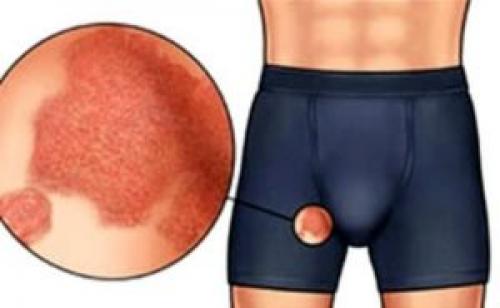
The inflammatory process that occurs due to skin irritation is called diaper rash. Irritation occurs in the folds due to wetting with skin secretions and friction with each other.
Men produce a large amount of sweat in the groin area, which is a source of moisture in the inguinal folds. When moving, this leads to the formation of diaper rash. All this causes discomfort and pain.
Such skin irritations can lead to the following consequences:
- red or red-brown rash;
- itching, sores (sometimes they may even ooze blood);
- cracks or crusts.
If diaper rash occurs, you should consult a doctor. As a result of the examination, treatment will be prescribed, as well as checking the affected skin for infections.
Causes

There are various causes of diaper rash in the groin area in men. The most common ones include the following:
- increased sweating, which can be a separate disease or the cause of a developing disease;
- being overweight or obese (feet touching more tightly and causing constant friction on the skin);
- disturbances in the microflora of the genitals;
- refusal of norms and rules for body care (leads to constant accumulation of sweat in the folds, as well as the development of bacteria);
- allergies caused by hygiene products;
- synthetic underwear (poorly “breathable” and tight fabrics slow down the evaporation of sweat from the groin area);
- urinary incontinence;
- genetic predisposition;
- infectious diseases of the genital organs;
- inflammation of prostate tissue;
- very sensitive skin in the groin area;
- oncological diseases.
Even a healthy man needs to carefully observe genital hygiene so as not to encounter the problem of diaper rash.
Diagnosis by a doctor
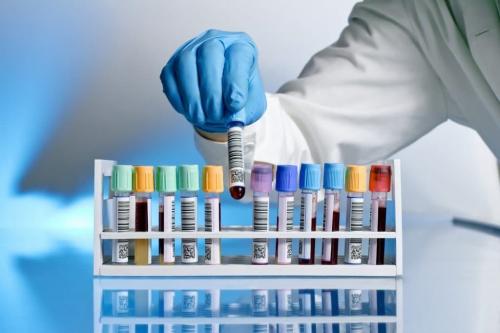
If a man begins to experience the following symptoms in the groin, he should consult a doctor:
- itching;
- burning;
- nervous tension;
- feeling of pain and discomfort.
Since all this can be signs of diaper rash. It will not be difficult for a doctor to diagnose this disease. There are three stages of lesions:
- first stage - the skin is not damaged, only redness is observed;
- second stage - cracks in the skin are noticeable, pustules are possible if there is an infection;
- third stage - erosion with protruding blood and a brown coating on the skin with an unpleasant odor are observed.
Diagnosing diaper rash does not take much time, so the doctor can only identify the reasons that caused the unpleasant disease. The dermatologist determines the stage visually, and additional studies are carried out to exclude psoriasis and other skin diseases.
We recommend reading:
Treatment

Treatment for diaper rash in the groin area in men depends on the stage of skin damage. Therefore, an experienced specialist will help you choose the right drugs to combat the disease.
First stage
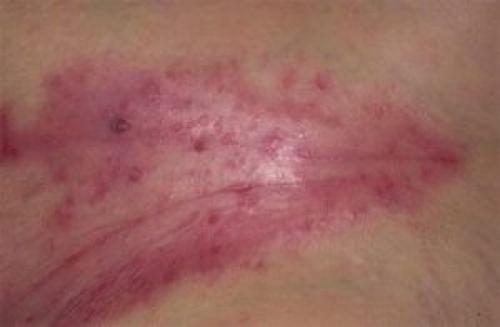
Therapy for this type of diaper rash is the simplest. It consists of constant adherence to intimate hygiene, which will help eliminate irritating factors.
